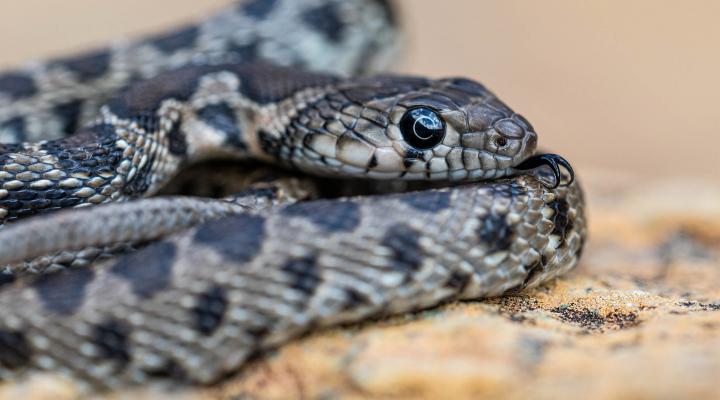
Spain might not be famed for its huge collection of dangerous animals: you’re not going to be eaten by a crocodile whilst river swimming here! But that doesn’t mean that you won’t find a host of venomous creatures in Spain, and some of these can cause harm if they bite or sting you.
To help you avoid falling foul of the wrong kinds of creepy crawlies, here is a comprehensive list of all of the venomous creatures that are native to Spain:
Recluse Spider
Although there are no documented cases of someone being killed by a spider bite in Spain, in 2021 a recluse spider bit a British tourist in Ibiza who subsequently lost two fingers. If you’re trying to spot one of these spiders then you need to know that they are large, brown, and have a distinctive marking on their back that is shaped like a violin. A recluse spider bite will be very painful, and they will often itch too. Once bitten, the bite will develop into an open sore: you should seek medical treatment for this, as if the sore becomes infected it can lead to extended damage. You should be particularly aware of these spiders if you’re spending time in Andalusia, as they are most common here.
Black Widow Spider
Everyone has heard about the deadly black widow spider, but did you know a version of these spiders was native to Spain? Most commonly found in Almería, Aragón, Andalusia and Valencia, you can identify these spiders by their black heads and the distinctive red hourglass shape on their backs. Black widow spiders' venom can be deadly, but luckily the venom of the versions found in Spain is not as toxic as their north American counterpart. Nevertheless, if you are bitten by a black widow spider, they can still cause symptoms such as fever, blindness, vomiting and asphyxiation, and you should seek medical attention.
Snakes
There are five different types of venomous snakes currently native to mainland Spain, and between one and seven people in Europe are killed by snake bites every year. That means that although it is exceptionally rare to suffer a snake bite in Spain, it is possible. The five types of venomous snakes that you need to be aware of are:
- Asp Viper. These are brown snakes with black stripes. If you are bitten by an asp viper you should seek immediate treatment, as untreated bites can occasionally be fatal.
- Seoane’s Viper. These are grey or black with brown zig zag patterns on their back. Their bite is not usually fatal, but can be to the elderly, the very young, or the vulnerable. You may find these snakes in Galicia, Castilla y León, the Cantabrian coast and the Basque Country.
- Snub-nosed or Lataste’s viper. These are grey snakes with a zig zag pattern down their nose and, as the name suggests, a snub-shaped nose. You will find these snakes throughout Spain, so should be aware of them in dry and rocky habitats.
- False smooth snake. These snakes are small but that doesn’t mean they aren’t venomous. Grey with brown spots, the good news is that it is very rare to be bitten by a false smooth snake, and their venom is very mild.
- Montpellier Snake . This is a very distinctive and easy to identify snake, as it is long, bluey green in colour, and has a white underbelly. These snakes have a mild venom, but their bites can still be very painful: luckily they very rarely bite.
Caterpillars and Centipedes
You will spot caterpillars and centipedes all over Spain, but only two types of these pose any risk of harm to humans. These are the hairy pine processionary caterpillar and the Megarian banded centipede. The pine processionary caterpillar can cause a rash and even temporary blindness, and so you should avoid touching these if you spot them. The black and yellow megarian banded centipede should also be avoided, because its bite can be very painful.
Jellyfish
If you step off land and into the water then you will find a greater risk to your health in waters that surround Spain. There are a huge number of venomous jellyfish in Spain that you need to be aware of. These are:
- Purple stinger. As the name suggests, these jellyfish are pruple and have a bell-shaped umbrella top. They have long tentacles that can be as long as 3 metres, and their stings can be very painful, even leaving permanent scars. However their stings cannot be fatal.
- Flower hat jellyfish. Another jellyfish that looks just like its name, these are clear and their tentacles are often pink tipped. If you are stung by a flower hat jellyfish you will develop a rash: this is unlikely to be fatal, but could be to the most vulnerable, with one death recorded in the 1970s.
- Sea wasp jellyfish. Another clear coloured jellyfish, these jellyfish are amongst the rarest on this list and its sting, whilst painful, is also not considered to be dangerous.
- Portuguese Man O’ War. Finally, this creature is the deadliest of all the animals on this list, and its stings can be life-threatening. These creatures are becoming more prevalent in European waters, so if you see one, you should get out of the water immediately. With tentacles that can be over 30ft long, these creatures have an incredible reach, and the best way to avoid them is to not be in the water with them at all!
Ticks and mosquitoes
Finally, although they are not venomous, ticks and mosquitoes deserve a spot on this list because of the potentially harmful diseases that they can carry. As well as being itchy and painful, tick and mosquito bites can also cause more serious issues. An example of this is the 2020 outbreak of West Nile virus in Andalusia, which was transmitted through the community via mosquito bite.
Are you thinking of moving to Spain? Looking to buy your holiday bolt hole, or to relocate and start an idyllic new life in Spain? Then why not get in touch with our local property experts, who are perfectly placed to assist you with your property search.

 English
English Español
Español Deutsch
Deutsch Français
Français Svenska
Svenska Nederlands
Nederlands Italiano
Italiano Norsk
Norsk Русский
Русский

































